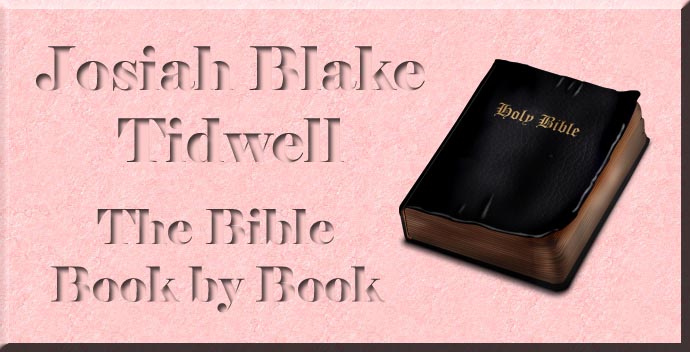
The Bible Book by Book
By Josiah Blake Tidwell
Part B - The Bible Book by Book
Chapter 11
|
Ezra, Nehemiah and Ester. Ezra and Nehemiah. Name. Ezra and Nehemiah were formerly counted as one book and contain the account of the restoration of the exiles to Jerusalem and the re- establishment of their worship. They soon came to be called First and Second Ezra. Jerome first called the second book Nehemiah. Wycliffe called them the first and second Esdras and later they were called the books of Esdras otherwise the Nehemiahs. The present names were first given in the Geneva Bible (1560). Ezra is so called from the author and principal character, the name meaning "help". Nehemiah is so called from the principal character, whose name means "Jehovah comforts." Other Books. Three other books should be read in connection with this study. (1) The book of Esther, which relates to this time and should be read between chapters 6 and 7 of the book of Ezra. (2) The books of Haggai and Zechariah. These two prophets were associated with the first return of Zerubbabel and their words incited the Jews to complete the temple in spite of opposition. The Return from Captivity. The return consisted of three expeditions led respectively by Zerubbabel. Ezra and Nehemiah. The time covered can not be accurately calculated. It is probably not fewer than ninety years. Some think it may have been as many as one hundred and ten years. Analysis of Ezra. I. The Rebuilding of the Temple, Chs. 1-6.
II. The Reforms of Ezra, Chs. 7-10.
For Study and Discussion. (1) The traits of character displayed by Ezra. (2) The reforms of Ezra. (a) What were they? (b) Parallel conditions of today. (3) The adversaries of Judah. (a) Who were they? (b) The nature of their opposition. (4) The decree of Cyrus. (5) The expedition of Zerubbabel and Ezra. (6) Ezra's commission and the king's orders 7:1-26. (7) God's use of friends and enemies in forwarding his purposes. Analysis of Nehemiah. I. The Rebuilding of the Wall, Chs. 1-7.
II. The Covenant to Keep the Law, Chs. 8-10.
III. The Walls Dedicated and Nehemiah's Reform, Chs. 11-13.
For Study and Discussion. (1) Point out elements of strength in the character and work of Nehemiah. (2) The greatness and difficulty of Nehemiah's task, (a) the rubbish, (b) the size and length of the wall, (c) the strength of their enemies. (3) The reforms of Nehemiah, (a) religious, (b) moral, (c) political. (4) The public meeting and new festival, 8:1-18. (5) The covenant 9:1-10:39. (6) The repeopling of Jerusalem, Chs. 11-12. Ester Name. This is taken from its principal character, a Jewish maiden became queen of a Persian King. Purpose. To explain the origin of the feast of Purim work of providence for God's people. Time. The events narrated are thought to have occurred about 56 years after the first return of Zerubbabel in 536 B. C. The King then would be Xerxes the Great, and the drunken feast may have been preparatory to the invasion of Greece in the third year of his reign. Connection with Other Books. There is no connection between Esther and the other books of the Bible. While it is a story of the time when the Jews were returning to Jerusalem, and very likely should come between the first and second return, and, therefore, between the sixth and seventh chapters of Ezra, the incident stands alone. Without it we would lose much of our knowledge of that period. The Story. While Esther stands out as the principal character, the whole story turns on the refusal of Mordecai to bow down to Haman, which would have been to show him divine honor. He did not hate Haman but, as a Jew could not worship any other than God. He dared to stand for principle at the risk of his life. The Name of God. One of the peculiarities of the book is that it nowhere mentions the name of God, or makes any reference to him. This may be because his name was held secret and sacred at that time. However, God's power and His care of His people are everywhere implied in the book. Analysis I. Esther Made Queen, Chs. 1-2.
II. Haman's Plot and its Defeat. Chs. 3-8.
III. The Jews' Deliverance, Chs. 9-10.
For Study and Discussion. (1) The character of the king, Vashti, Mordecai, Esther and Haman. (2) Mordecai's plea to Esther. (3) The honor of Mordecai and humiliation of Haman, Ch. 6. (4) The destruction of their enemies. (5) The feast of Purim, 9:17-32. (6) Truth about God seen in this book. (7) Why not name the book Mordecai or Vashti-are they not as heroic as Esther? (8) The race devotion of the Jews, then and now. (9) Persian life as seen in the book.
|
|
 |
 |
|
|
|
-
Site Navigation
 Home
Home What's New
What's New Bible
Bible Photos
Photos Hiking
Hiking E-Books
E-Books Genealogy
Genealogy Profile
Free Plug-ins You May Need
Profile
Free Plug-ins You May Need
 Get
Java
Get
Java.png) Get Flash
Get Flash Get
7-Zip
Get
7-Zip Get Acrobat Reader
Get Acrobat Reader Get
TheWORD
Get
TheWORD